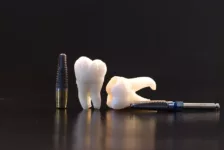When it comes to replacing missing teeth, there’s no option that is as long-lasting and promising as dental implants. In nearly 98% of cases, implants are likely to last for the entire lifespan of the patient. Compared to other types of tooth replacement treatments, implants provide the best return on investment.
What are Dental Implants?

Implants are essentially artificial, manmade “tooth roots.” Crafted from biocompatible materials like titanium, these artificial roots are placed into the bone, where the missing tooth originally once stood.
The titanium from the implant stimulates bone growth and fusion of the implant into the jaw. This process is known as “osseointegration.” As long as this step is successful, a dental implant patient should be able to maintain the new restoration for decades.
Variations of Implant Designs
Traditional implants are cylinder-shaped to resemble a natural tooth root. But for people who don’t have adequate bone, other types of implants are available: such as zygomatic implants, which are anchored into the cheekbone instead of the jaw.
Mini dental implants are useful for non-load-bearing teeth or denture stabilization, when bone quantity is low. There are otherdental implant variations that are not as commonly used, but due to the extensive range of modern implant therapy, very few people can say they are not a candidate for treatment. It’s just essential to find a provider who offers the best type of implant for the given situation.
Types of Implant Restorations
Being that implants are only the artificial “roots” of the tooth, it’s necessary to select a specific type of restoration to anchor on top of an abutment, which is affixed to the implant. The type chosen will depend on how many teeth are missing, and the number of implants that are used.
For example,
• A dental crown would likely be recommended for single tooth replacement
• Dental bridges can replace several teeth at once, when anchored over at least two implants
• Implant-supported dentures are full-arch prostheses that can either be permanently attached to implants, or feature a snap-in/snap-out option
The Initial Consultation
Before starting implant treatment, it’s important to undergo a consultation with the dentist or specialist placing them. During the visit, the dentist will thoroughly examine the health of the patient, take x-rays to assess the quality of bone, and talk about the concerns/needs that are to be addressed.
From here, a treatment plan will be constructed that outlines the number of implants, types of restorations, number of appointments, a breakdown of your estimated insurance benefits, patient-pay requirements, and total costs involved. Financing options will also be reviewed.
Your Dental Implant Surgery
Once the patient decides to move forward with obtaining dental implants, the first appointment is the surgical placement. In some cases — if diseased teeth need to be removed — other teeth will typically be extracted on the same day. Otherwise a few months of healing need to take place between extractions and implant surgery, depending on individual circumstances.
In certain situations, same-day dental implants can also be installed. These implants are restored on the very same date as surgical placement, in select few cases.
Follow-up and Recovery
After surgery, a healing cap or other temporary prosthesis will be placed over the area of the implant site. This helps alleviate aesthetic concerns as new bone integrates around the dental implant and prevents foreign objects (like food particles) from entering the wound as it heals. Full osseointegration usually occurs within three to six months. During this time, it is important to avoid chewing on your surgical site or using tobacco products.
Prosthesis Delivery
Once osseointegration occurs, an implant can support the final restoration. Any temporary prosthetics will need to be removed, and the permanent version will be custom-made to replace them.
The ultimate goal of the final restoration is to restore both function and aesthetics to the smile. Durable porcelain materials are typically chosen, as they look natural and withstand everyday wear.
Maintenance
Implant crowns, bridges, and dentures should be cleaned carefully each day. Although implants are not natural teeth, they can still collect plaque buildup. As such, the gums around them can become infected and result in “peri-implantitis,” a condition similar to gum disease. If this occurs, the implant could fall out.
Patients should continue to see their dentist and hygienist every six months. Routine visits allow the implants to be professionally cleaned and monitored for signs of complications, so that problems can be caught early or averted altogether.
Thanks to modern advancements in implantology, 3D surgical guides, and the success of treatment, dental implants are an option for more people than they have ever been in years past, allowing patients to enjoy the foods they love and smile with confidence.








